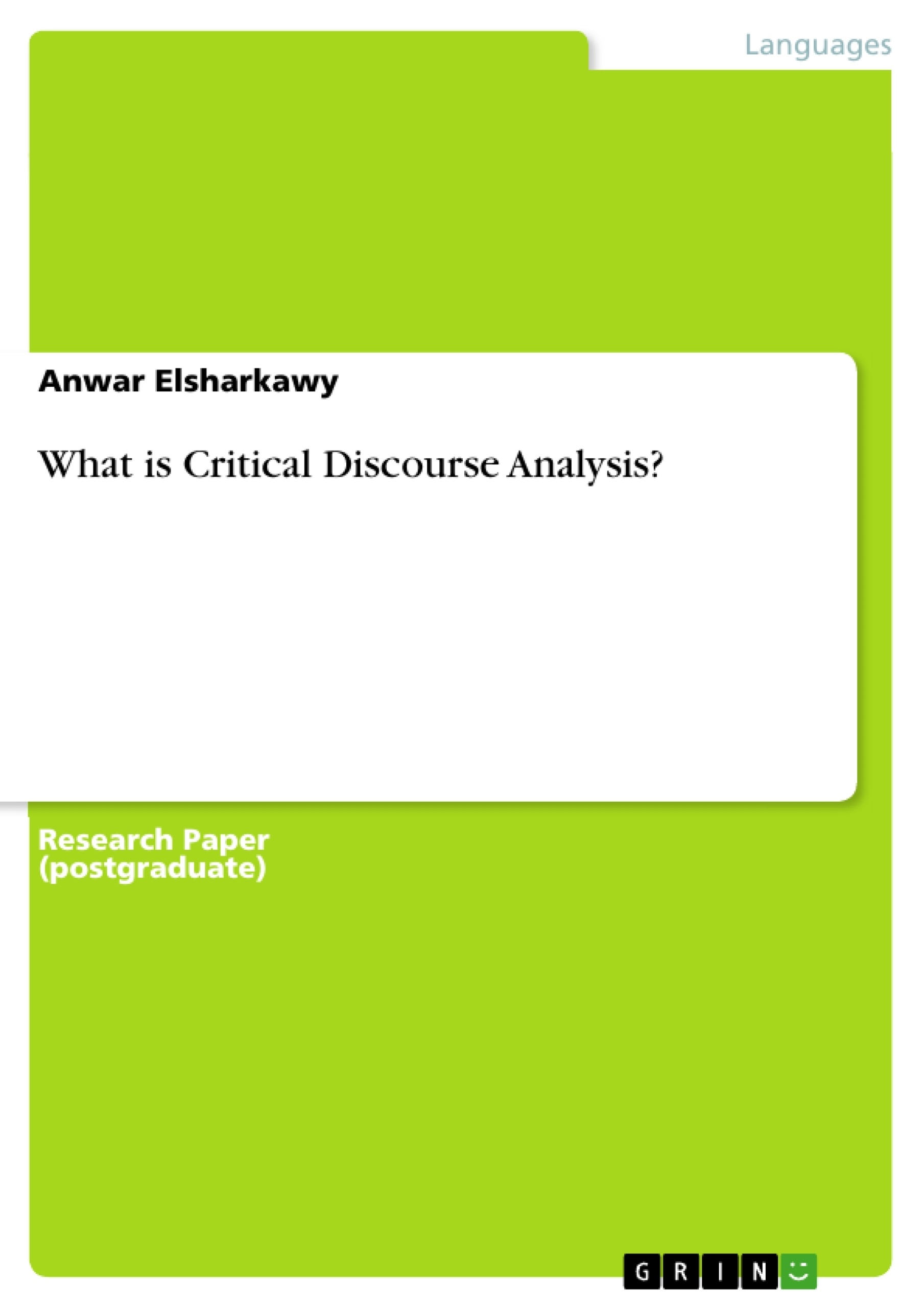In this paper, a historical outline of Critical Discourse Analysis (CDA) will be presented, and some notions and concepts, such as discourse, critical, text, and semiosis, will be clarified. In doing so, many relationships of CDA to other components such as social structure, social event, social practice, and orders of discourse are introduced in such ways that grant redefinitions to discourse and discourse analysis as well as show why CDA is critical and how its constructing components (critical, discourse, and analysis) draw its meaning and contribute to form its aims and principles.
Table of Contents
- 1.0 Introduction
- 1.1 CDA: Historical Outline
- 1.2 What is Discourse?
- 1.3 Discourse as Social Practice
- 1.4 Text, Discourse, and Semiosis
- 1.6 What is Critical in Discourse Analysis?
- 1.7 Intertextuality and (Inter)disciplinarity
- 1.7.1 Intertextuality
- 1.7.2 Interdisciplinarity
- 1.7.3 Transdisciplinarity
- 1.8 The critique of CDA
- 1.9 Conclusion
Objectives and Key Themes
This paper aims to provide a historical overview of Critical Discourse Analysis (CDA) and clarify key concepts such as discourse, criticality, text, and semiosis within its framework. It explores the relationships between CDA and other fields like social structure and practice, ultimately redefining discourse analysis and highlighting CDA's critical nature and its constituent elements.
- Historical development of CDA
- Defining discourse and its social implications
- The critical dimension of CDA
- The relationship between language, ideology, and power
- CDA's connection to other disciplines
Chapter Summaries
1.0 Introduction: This introductory chapter sets the stage for the paper by outlining its objectives: to present a historical overview of Critical Discourse Analysis (CDA) and to define key concepts such as discourse, criticality, text, and semiosis. The chapter foreshadows the exploration of the relationship between CDA and social structures, practices, and events, promising a re-evaluation of discourse analysis itself. It highlights the crucial role of understanding how the ‘critical,’ ‘discourse,’ and ‘analysis’ components contribute to CDA's meaning, aims, and principles.
1.1 CDA: Historical Outline: This chapter traces the historical roots of CDA, highlighting its origins in Classical Rhetoric, Text Linguistics, Sociolinguistics, Applied Linguistics, and Pragmatics, and its connection to the critical theory of the Frankfurt School. It emphasizes the influence of neo-Marxist and postmodernist thinkers like Foucault and social linguists like Pecheux in shaping CDA's understanding of ideology's relationship with discourse. The chapter details the evolution from Critical Linguistics (CL), emphasizing the shift from a formal grammatical approach to one incorporating Halliday's functional grammar, which views language as performing ideational, interpersonal, and textual functions. The chapter notes the role of Fairclough in establishing CDA as a distinct field and the contrasting view of van Dijk who sees CDA and CL as sharing a perspective on discourse analysis. Finally, the chapter positions CDA as a reaction against dominant formal and uncritical paradigms prevalent in the 1960s and 70s.
Keywords
Critical Discourse Analysis (CDA), Discourse, Critical Linguistics, Ideology, Power, Language, Social Practice, Semiosis, Text, Intertextuality, Interdisciplinarity, Social Structure.
Frequently Asked Questions: A Comprehensive Language Preview of Critical Discourse Analysis
What is the purpose of this document?
This document provides a comprehensive overview of Critical Discourse Analysis (CDA), including its historical development, key concepts, and critical themes. It serves as a preview, offering a table of contents, chapter summaries, objectives, and keywords for a more in-depth study of CDA.
What key concepts are defined in this preview?
The preview defines and explains crucial concepts within CDA, such as discourse, criticality, text, and semiosis. It explores how these concepts interrelate and contribute to the overall framework of CDA.
What is the historical background of CDA covered in this preview?
The historical overview traces CDA's origins back to Classical Rhetoric, Text Linguistics, Sociolinguistics, Applied Linguistics, and Pragmatics, and its connection to the Frankfurt School's critical theory. It highlights the influence of key figures like Foucault and Pecheux and the evolution from Critical Linguistics (CL).
What are the main themes explored in this preview?
The preview explores the relationship between CDA and social structures and practices, the critical dimension of CDA, the connection between language, ideology, and power, and the interdisciplinary nature of CDA. It emphasizes the importance of understanding how the 'critical,' 'discourse,' and 'analysis' components contribute to CDA's meaning.
What is the relationship between CDA and other disciplines?
The preview discusses CDA's interdisciplinary nature, highlighting its connections to fields like social structure, social practice, linguistics, and critical theory. It also touches upon the concepts of intertextuality and transdisciplinarity within CDA.
What are the chapter summaries included in the preview?
The preview includes summaries of the introductory chapter, which sets the stage for the paper and outlines its objectives, and a summary of the chapter on the historical outline of CDA. These summaries provide a brief overview of the content and arguments presented in each chapter.
What are the keywords associated with this document?
The keywords include: Critical Discourse Analysis (CDA), Discourse, Critical Linguistics, Ideology, Power, Language, Social Practice, Semiosis, Text, Intertextuality, Interdisciplinarity, and Social Structure.
What is the overall aim of this document?
The overall aim is to provide a clear and concise introduction to CDA, making it accessible to those unfamiliar with the field. It aims to stimulate interest and provide a foundation for further study.
- Quote paper
- Anwar Elsharkawy (Author), 2013, What is Critical Discourse Analysis?, Munich, GRIN Verlag, https://www.grin.com/document/349819




